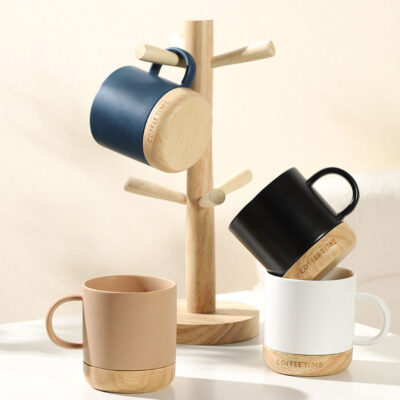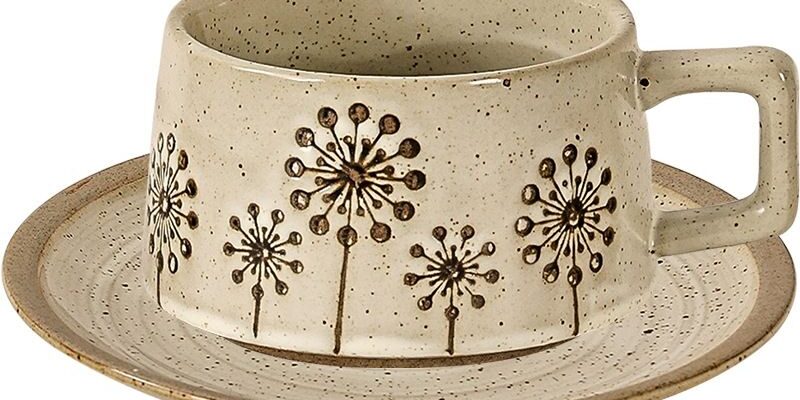When developing a product line for cafés, outdoor brands, or retail promotions, one of the first decisions is whether to choose enamel or ceramic mugs. Both offer unique visual appeal and performance characteristics, yet their production, durability, and branding flexibility differ significantly. Understanding these factors helps importers and distributors make the right sourcing decision for each market segment.
⚙️ Material Composition and Construction
Enamel mugs are made from pressed steel coated with a thin layer of vitreous enamel, fired at high temperatures to create a glossy, chip-resistant surface. This structure makes them lightweight and durable, ideal for outdoor or camping use.
By contrast, ceramic mugs are made from clay fired at high temperatures, resulting in a denser, heavier, and more thermally stable body. Buyers working with Ceramic Mug Manufacturers can access a wider range of glaze finishes, colors, and branding options that appeal to hospitality and retail customers.
🔥 Durability and Usage Environments
Durability is one of the biggest differentiators between the two materials. Enamel mugs resist cracking and are nearly unbreakable during travel or field use. However, they may chip around the rim if dropped on hard surfaces.
Ceramic mugs, while more fragile, offer excellent heat retention and scratch resistance for indoor or café environments. They also maintain their aesthetic appeal over time—making them the top choice for branding and tableware programs in hotels and restaurants.
🌡️ Thermal Performance and Comfort
Ceramic mugs excel at keeping beverages warm for longer periods due to their dense clay body and higher heat capacity. This makes them perfect for cafés and home use, where tactile comfort and beverage temperature matter.
Enamel mugs cool faster and can heat quickly when used over campfires or stoves. Their versatility and lightweight design make them popular among hikers, campers, and travel gift retailers seeking a rugged, nostalgic look.
🎨 Branding and Customization Options
From a branding perspective, ceramic mugs provide greater freedom. They can be pad printed, screen printed, laser engraved, or fully wrapped with custom artwork. Glaze effects such as matte, speckled, or reactive finishes allow premium differentiation for retail markets.
On the other hand, enamel mugs are usually branded with single-color prints or heat transfers to maintain coating integrity. For buyers exploring outdoor-themed or vintage collections, partnering with Metal Enamel Mugs Manufacturers ensures proper coating adhesion and long-lasting logo visibility.
🧪 Food Safety and Compliance
Both enamel and ceramic mugs must pass food-contact safety tests such as LFGB, FDA, and California Proposition 65. The key difference lies in glaze or enamel formulation. Premium ceramic glazes today are lead-free and cadmium-free, while enamel coatings are typically inert once fired, making them safe for regular use.
For importers, requesting migration test reports and batch-level certification is essential—especially when targeting the EU or North American markets where regulations are strict and audits are frequent.
🚢 Logistics and Cost Considerations
In terms of logistics, enamel mugs have a clear advantage. Their steel bodies make them thinner and lighter, allowing more units per carton and lower shipping costs. They’re also stackable, reducing breakage during transport.
Ceramic mugs, while heavier, tend to deliver higher retail value and perceived quality. With proper packaging—like foam dividers or double-wall cartons—their breakage rates can remain under 1%. Many buyers combine both materials in their product lines to serve different customer needs and price points.
🧭 Market Segmentation and Applications
| Market Type | Recommended Material | Rationale |
|---|---|---|
| Outdoor/Camping | Enamel | Lightweight, durable, nostalgic aesthetics |
| Hospitality & Café | Ceramic | Premium appearance, heat retention |
| Promotional Gifting | Both | Enamel for outdoor events; ceramic for indoor branding |
| Retail & E-commerce | Ceramic | Broader customization, higher perceived value |
By balancing aesthetics, durability, and cost, importers can tailor product assortments for each sales channel effectively.
💡 Final Thoughts for Sourcing Managers
When deciding between enamel and ceramic mugs, the question isn’t which is “better,” but which suits your brand positioning and market. If your audience values adventure, mobility, and retro charm, enamel mugs deliver exceptional resilience. If they prioritize design refinement, café culture, or brand storytelling, ceramic mugs provide unmatched versatility and elegance.
By collaborating with specialized factories that understand both materials, you can offer customers a balanced product portfolio that meets global market expectations.









